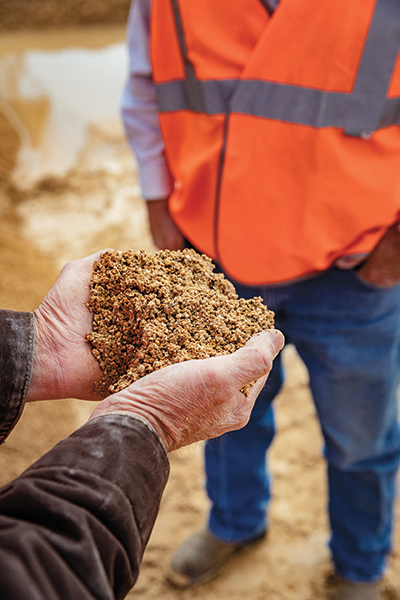How Texas-based Wheatcraft Materials found the right partner

Says Curtis Wheatcraft: “At the outset, we knew we were losing sand, but little did we know just how much of an uplift we would experience.” Photo: CDE
Family-owned and -operated Wheatcraft Materials has supplied the central Texas market and its local ready-mix batching plants with sand and gravel products since 1979.
The company has operated from its Red Rose Quarry outside of Kerrville, Texas, for most of its 41-year history, but the business expanded its operations in 2005 when Jerry Wheatcraft, the late company founder, purchased a new site near Center Point, Texas.
Curtis Wheatcraft, Jerry’s son and the current owner, took over the family business in 2006 shortly after Wheatcraft Materials began processing material at its new deposit.
Out with the old, in with the new
Similar to many operations in Texas and throughout North America, Wheatcraft Materials was originally operating with a traditional sand washing setup: a horizontal classifying tank and sand screw. But the equipment utilized on site had some limitations, according to Curtis.
“One of the biggest challenges we identified was that we were losing valuable sand due to the inefficiencies of the older technology,” he says.
That’s where CDE enters the picture.
“Wheatcraft is typical of most customers we have in Texas,” says Tom Wick, business development manager at CDE. “They had the traditional – or normal – sand washing equipment. What we found when we visited the site is that they were losing a lot of material across that screw and classifier into their ponds.”
Operational inefficiencies associated with outdated processing practices were leading to the loss of significant volumes of valuable fines, according to CDE.
“With just a short discussion, Joe [Davila], the plant manager, was able to convince Curtis that he needed to look at our technology,” Wick says. “We had the equipment that could integrate with their existing plant setup to capture more sand.”
Analysis & solution

The EvoWash plant at Wheatcraft Materials integrates a dewatering screen, sump and hydrocyclones. Photo: CDE
CDE technical engineers visited Wheatcraft’s site and closely monitored the plant process to better understand the challenges and limitations the company faced. Sample feed material was tested and analyzed to develop an engineered solution that would enable Wheatcraft to capture valuable fines to maximize its yield and profitability.
Taking into consideration the site footprint and the customer’s requirements, CDE proposed an upgrade to Wheatcraft Materials’ plant that would integrate with the existing system to ensure the company could continue to operate at full feed capacity.
“We brought in our own technical engineers, we looked at the process and saw how we could improve it,” Wick says. “We replaced the traditional horizontal classifying tank and sand screw with the EvoWash technology.”
CDE’s EvoWash technology – a compact, modular sand washing system – integrates a high-frequency dewatering screen, sump and hydrocyclones to help control silt cut points and eliminate the loss of quality fines. The EvoWash incorporates CDE’s Infinity screen technology, allowing Wheatcraft to produce a range of sands that are market-ready straight from the belt.
“As soon as we turned it on and started feeding the plant, we could tell there was more material hitting the ground than normal,” Davila says. “We were making almost twice as much sand as we had been making in the past.”
The higher feed capacity has, in turn, enabled Wheatcraft to increase its production levels across the board.

Curtis Wheatcraft, right, shows off some of the additional sand Wheatcraft Materials is capturing alongside CDE’s Tom Wick. Photo: CDE
“Now the plant can handle everything we can put in it,” Davila says. “We increased production on our gravel products simply because we’re able to feed the plant more. As soon as our smaller gravels hit the ground, they’re pretty much sold. It’s the same with our larger gravels, too.”
With increased capacity at Wheatcraft Materials’ wash plant, the new equipment paid off in more ways than one.
“After getting the equipment installed, Curtis told us that it paid for itself after just four months,” Wick says. “Wheatcraft Materials has invested in the right technology at the right time for their business. They have a solid market position in central Texas and a strong customer base who recognize the quality of the materials they produce.
“We’ve improved the process, addressed the inefficiencies and put in place a system that has enabled Curtis and his team to enjoy huge increases in production,” Wick adds.
From Wheatcraft’s perspective, the partnership with CDE has transformed the operation.
“At the outset, we knew we were losing sand, but little did we know just how much of an uplift we would experience,” Curtis says. “An efficient plant, capturing more sand, and rapid return on investment has been nothing but a win-win situation.”









